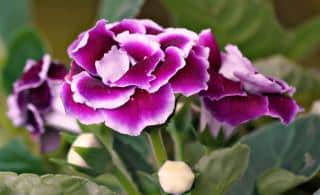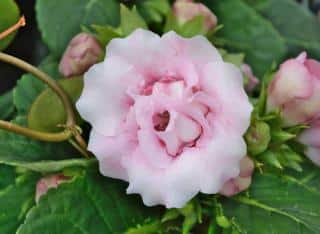

Gloxinia embellishes our homes thanks to its magnificent blooming.
Key Gloxinia facts
Name – Sinningia speciosa
Family – Gesneriaceae
Type – perennial, indoor plant
Height – 8 to 12 inches (20 to 30 cm)
Exposure – part sun
Soil – rich enough, soil mix
Foliage – evergreen
Blooming – May to October
Planting, care, watering and repotting are parameters that influence and will lead to successfully growing your gloxinia.
It is recommended to plant the tubers in spring in a blend of garden soil and heath soil.
Repot in spring, generally April does the trick.
Favor a bright spot but without direct sunlight, especially during the hottest hours.
You can put saintpaulia in the immediate vicinity of this plant because they both share the same growing conditions.
Remove wilted flowers often to spur appearance of new buds.

This will ensure you have a beautiful blooming during this entire period.
Early September, slowly stop adding the fertilizer and stop it completely in October.
Once the flowers have died off, you must reduce the watering until the leaves as well have also withered and died.
Once there are no more leaves left, transfer your gloxinia to a cool, shaded and rather dry spot.
Ideal temperatures for this rest phase are around 57 to 60°F (13 to 15°C).
At the end of winter, repot the tuber in new soil mix and begin watering regularly again.
As soon as the first buds appear, water abundantly and there you go, your gloxinia is ready for a new cycle of blooming.

Caring for it is relatively easy if the guidelines mentioned above are properly followed.
In the early 19th century, in 1815, this flower was introduced in England under the horticultural name Gloxinia. However, research showed that this “Florist’s Gloxinia” is only distantly related to the actual Gloxinia family (or genus).
That’s why the real name of the flower was later corrected to Sinningia speciosa.
How to get more bulbs tubers from one gloxinia bulb? Any other way to create more bulbs?
Hi Kishore, a healthy, well-fertilized plant will start producing side tubers around the main original tuber. Gloxinia is a tuber more than a bulb because the inside of the tuber is homogenous, like a potato. Bulbs, on the other hand, are more like layers in an onion or cloves as in garlic. This means you can separate secondary tubers from the original one. You can even, with some success, split a large tuber into two halves. It’s important to deal with fungus, since open wounds on the tubers would make the plant sick. Here are a few tips on how to manage fungus on seedlings and cuttings.
More of a question. How much LED lighting do gloxinias need per day? Started this mixed variety in February and just bought 6500 lumen LED grow lights. They are all in 4 inch pots now and 22 of 24 are doing well using lights on 12 hours.
Hi Rick, there isn’t really a standard answer to that since, for instance, distance from light bulb to plant isn’t always the same. Also, the type of reflector you have channels more or less of the light to the plant depending on the design.
The Alabama Cooperative extension recommended 14 to 16 hours of lighting for gloxinia, with a brightness of 200 footcandles at soil level. It’s important not to place the light too close to the plants, or you’ll burn them. Not enough light leads to up-reaching leaves that are leggy. Light too close will kill the green in the leaves and you’ll be left with yellow, condemned leaves. It’s always possible to save a leggy plant, but a burnt one is harder!
You can also try rotating your plants to different spots under the light, say every couple days or once a week. That might explain why the two are having a harder time, maybe they’re too close or too far from a hotspot.
Where can I buy liquid flower plant fertilizer?
Hi Patrick! Almost every garden store or horticulture center should have liquid plant fertilizer for sale. Sometimes flower shops sell them, too. Just follow recommended doses, don’t ever increase them or you’ll “burn” the plant. You can reduce them without problem, though, since usually only very little is needed.
However, you can also make your own if you’ve got a pail or bucket. Indeed, many types of fermented tea prepared from weeds make excellent fertilizer.